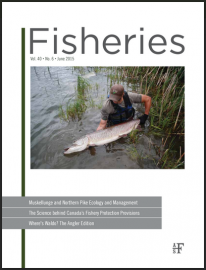Standardized Removal and Sectioning Locations for Common Carp Dorsal Spines
Zachary B. Klein (Presenter) and Carson J. Watkins, Idaho Cooperative Fish and Wildlife
Research Unit, University of Idaho, [email protected]
Marc M. Terrazas, Department of Fish and Wildlife Sciences, University of Idaho
Michael C. Quist, U.S. Geological Survey, Idaho Cooperative Fish and Wildlife Research Unit,
Department of Fish and Wildlife Sciences, University of Idaho
Common Carp Cyprinus carpio is known to cause deleterious effects on water quality and fish
assemblage structure outside of their native distribution. In systems where Common Carp have
reached high abundances, effort has focused on improving altered habitat condition and oftentimes
suppressing populations to low levels. As such, Common Carp have garnered considerable
management attention focused on understanding dynamic rate functions of populations of concern.
Gaining information on dynamic rate functions and age structure; however, requires the use of
calcified hard structures that provide high quality information. Dorsal spines have been shown to
provide precise estimates of Common Carp age and are commonly used by management agencies to
gain information on Common Carp populations. However, no previous studies have evaluated the
techniques for removing and sectioning Common Carp dorsal spines. Standardization of fish
sampling and processing is critical for producing and maintaining data that are both meaningful and
comparable. However, inconsistencies may exist among agency personnel regarding dorsal spine
removal and sectioning that may result in age and growth data that are not useful for making
comparisons across populations and among individuals. The purpose of our study was to evaluate
the precision and distribution of age estimates obtained from various sectioning locations along
Common Carp dorsal spines. Additionally, we evaluated the readability of dorsal spine sectioning
locations and its relationship with precision in age estimates. We examined dorsal spines from 192
Common Carp sampled from Crane Creek Reservoir and Lake Lowell in southwestern Idaho. Dorsal
spines were sectioned at the base (i.e., near the curve in the dorsal spine where it forms the
articulating process), immediately distal to the basal section (i.e., where a section would be taken if
the dorsal spine was removal near the tissue of the fish), and at 25, 50, and 75% of the total length
of the dorsal spine. Exact agreement (PA-0) and with-1 year agreement (PA-1) between readers
was highest and the coefficient of variation lowest for section 2. Assuming section 1 represented
the true age, age distributions for sections 2 and 3 were not significantly different. Mean
confidence rating was highest for section 2 and confidence ratings were not significantly different
among sections 1, 2, and 3. In general, age distributions from sections 2 and 3 were similar to
section 1 and sections 2 and 3 also displayed the highest concordance in age estimates with section
1.

